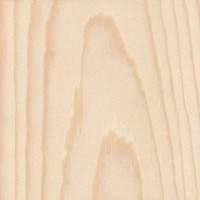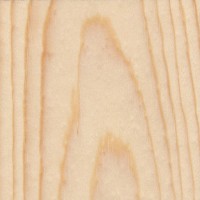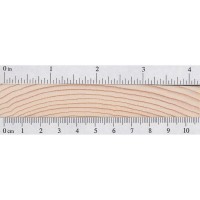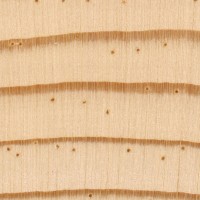 |
Common Name(s): Jeffrey Pine
Scientific Name: Pinus jeffreyi Distribution: Mountainous regions of southwestern Oregon to California and northern Mexico Tree Size: 100-165 ft (30-50 m) tall, 2-4 ft (.6-1.2 m) trunk diameter Average Dried Weight: 28 lbs/ft3 (450 kg/m3) Specific Gravity (Basic, 12% MC): .37, .45 Janka Hardness: 500 lbf (2,220 N) Modulus of Rupture: 9,300 lbf/in2 (64.1 MPa) Elastic Modulus: 1,240,000 lbf/in2 (8.55 GPa) Crushing Strength: 5,530 lbf/in2 (38.1 MPa) Shrinkage:Radial: 4.4%, Tangential: 6.7%, Volumetric: 9.9%, T/R Ratio: 1.5 |
Color/Appearance: Heartwood is reddish brown, sapwood is yellowish white.
Grain/Texture: Straight grained with medium texture.
Endgrain: Medium-large resin canals, numerous and evenly distributed, mostly solitary; earlywood to latewood transition fairly abrupt, color contrast can vary depending on growth ring spacing; tracheid diameter medium-large.
Rot Resistance: The heartwood is rated as moderate to low in decay resistance.
Workability: Jeffrey pine works well with both hand and machine tools. Glues and finishes well.
Odor: Jeffrey Pine has a faint, vanilla or apple-like odor while being worked.
Allergies/Toxicity: Working with pine has been reported to cause allergic skin reactions and/or asthma-like symptoms in some people. See the articles Wood Allergies and Toxicity and Wood Dust Safety for more information.
Pricing/Availability: The wood of Jeffrey Pine is anatomically indistinguishable from that of Ponderosa Pine, and no commercial distinction is made between the lumber of the two species (both are simply sold as Ponderosa Pine). It should be widely available as construction lumber for a modest price. Some Ponderosa Pine is mixed with Lodgepole Pine and sold together as construction lumber under the stamp “PP/LP”.
Sustainability: This wood species is not listed in the CITES Appendices, and is reported by the IUCN as being a species of least concern.
Common Uses: Veneer, plywood, sheathing, subflooring, boxes, crates, posts/poles, interior trim, cabinetry, and construction lumber.
Comments: Named in honor of John Jeffrey, a Scottish botanist who documented the species in 1852. Jeffrey Pine was initially classified as just a variety of Ponderosa Pine, but it was later discovered to be an entirely distinct species.
Jeffrey Pine has a unique resin chemistry that is unlike other pine species, which also give a pleasing scent, which is variously described as being similar to vanilla, apple, buttersctoch, and/or lemon scents. (Interestingly, pure heptane can be distilled from the resin of Jeffrey Pine, which is so explosive that it was selected as the zero point on the octane rating scale.)
Although Jeffrey Pine is technically classified as a yellow (hard) pine, it shares many characteristics with white (soft) pines, having a considerably lower density than the yellow pine species found in the eastern United States.
- Austrian Pine (Pinus nigra)
- Caribbean Pine (Pinus caribaea)
- Eastern White Pine (Pinus strobus)
- Jack Pine (Pinus banksiana)
- Khasi Pine (Pinus kesiya)
- Limber Pine (Pinus flexilis)
- Loblolly Pine (Pinus taeda)
- Lodgepole Pine (Pinus contorta)
- Longleaf Pine (Pinus palustris)
- Maritime Pine (Pinus pinaster)
- Ocote Pine (Pinus oocarpa)
- Patula Pine (Pinus patula)
- Pinyon Pine (Pinus edulis)
- Pitch Pine (Pinus rigida)
- Pond Pine (Pinus serotina)
- Ponderosa Pine (Pinus ponderosa)
- Radiata Pine (Pinus radiata)
- Red Pine (Pinus resinosa)
- Sand Pine (Pinus clausa)
- Scots Pine (Pinus sylvestris)
- Shortleaf Pine (Pinus echinata)
- Slash Pine (Pinus elliottii)
- Spruce Pine (Pinus glabra)
- Sugar Pine (Pinus lambertiana)
- Sumatran Pine (Pinus merkusii)
- Table Mountain Pine (Pinus pungens)
- Western White Pine (Pinus monticola)
- Virginia Pine (Pinus virginiana)
Scans/Pictures: There are currently no pictures of this exact wood species, but a similar species within the Pinus genus is being substituted (P. ponderosa). If you’d like to contribute a wood sample of this specific species to be scanned, (even small pieces of veneer can be sent), please use the contact form.
 |
 |
 |
 |




